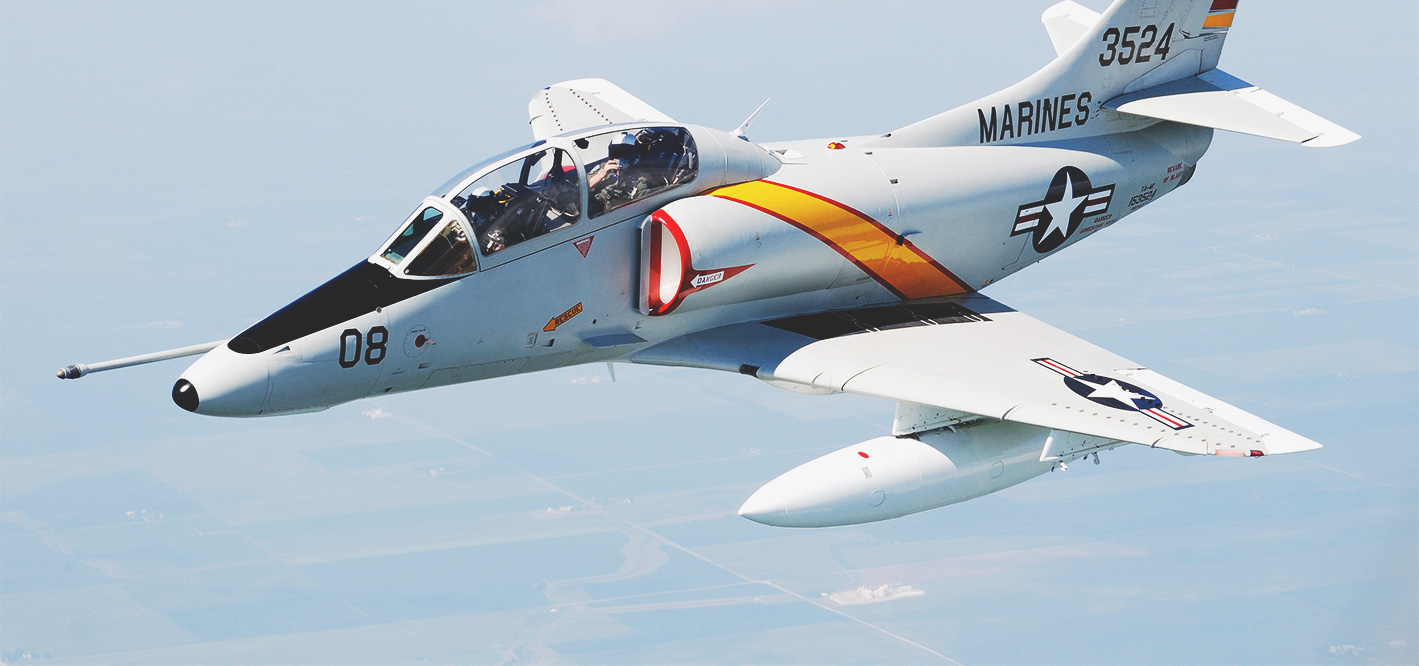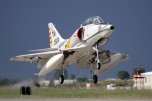“The Skyhawk remains one of the most flexible mission aircraft ever produced.”
With a diverse service life beginning in 1956 with an initial delivery to US Navy VA-72 Attack Squadron and extending into today as an aircraft still employed by many of the world’s air forces, the Douglas A-4 Skyhawk remains one of the most flexible mission aircraft ever produced. Known for its lightweight and small airframe supported by a powerful J52-P8 turbojet, the Skyhawk soon was dubbed “Heinemann’s Hot Rod” after its designer, Ed Heinemann. The type enjoyed service in many US Navy and Marine squadrons as a light attack aircraft and even as a trainer in both one and two seat versions. Though production ceased in 1979, the aircraft is still flown worldwide.
Douglas TA-4J Skyhawk, construction # 13590, was delivered to the U.S. Navy and accepted into the inventory on July 24, 1967. The aircraft was assigned Bureau Number 153524. “524” was immediately assigned to VF-126 at Miramar NAS. In 1967 the Skyhawk was being phased out of fleet as the main attack aircraft, VA 126, an A-4 fleet instrument training squadron known as the Fighting Seahawks was re-designated VF-126 Bandits. VF-126 began flying the adversary mission for the west coast from Miramar in April 1967. They were tasked to provide adversary training and continued to use the Skyhawk in that role because of its small size, exceptional maneuverability and smokeless engine until the squadron was disestablished in 1994. For a short time the Naval Fighter Weapons School (Top Gun) was attached to VF-126 until August 1972. Top Gun handled graduate air combat maneuvering courses for Naval pilots while VF-126 handled the “day to day” adversary role, supporting west coast F-4 and F-14 squadrons.
From July of 1967 to September 1967, “524” was flown regularly accumulating 66.9 hours of flight time in that short period. On September 9, “524” was damaged in a ground accident. Records indicate that severe damage to the nose area of the aircraft occurred necessitating repairs to the nose gear and forward fuselage structure. This repair took 8 months and the aircraft was not returned to service until June of 1968.
“524” continued to fly with VF-126 until April of 1976. In the nearly ten years since its assignment to VF-126 Bandits, the squadron had flown the aircraft for 3,592 hours.
The aircraft began its new duties in support of the National Parachute Test Range at Naval Air Facility El Centro immediately after being transferred from VF-126. While”524’s” usage with the NPTR is unclear at this time, the NPTR was the hub of research focused toward aeronautical escape system testing, evaluation, and design. The aircraft was assigned to the NPTR from April, 1976 until January, 1979. 524 was flown sparingly while assigned to the NPTR accumulating only 275 flight hours during the period.
Although the TA-4F was assigned to the National Parachute Test Range the actual controlling authority was the Research Development Test and Evaluation Office (RDT&E). This controlling authority transferred TA-4F BuNo 153524 to the Naval Air Test Center at NATC Patuxent River, Maryland. The aircraft was assigned to the weapons test squadron. “524” was utilized to test a variety of weapons and equipment while with the unit. It operated in this capacity from January 1979 until June 1983. While assigned to weapons test,“524” accumulated 958 flight hours.
Upon completion of its assignment in weapons test, “524” was assigned to the National Test Pilots School also located at Pax River in July of 1983. The aircraft was officially transferred to the Commander, Naval Air Systems Command as the controlling agency.
“524” was used as a flight test evaluation aircraft, often carrying data packages and rear cockpit camera systems to document flight instruments. The aircraft was also used as a TPS student syllabus aircraft. It was one of 4 TA-4s assigned to the TPS. “524” continued in this capacity until August 5, 1994. All four of the TPS TA-4s assigned to the TPS were flown to the Aircraft Maintenance and Regeneration Center at Tucson, Arizona. At this time BuNo 153524 and her sister ships were considered excess to U.S. Navy requirements. “524” had completed her Naval service with a total of 6496.6 hours.
The Collings Foundation was allocated a Douglas TA-4 Skyhawk through Congressional action in October 2000. After looking at various aircraft that were held in storage at AMARC BuNo 153524 was selected because the overall condition of the aircraft and its low airframe hours. The aircraft was removed from storage at AMARC, Tucson exactly one year after the legislation was signed into law. Negotiations with Navy attorneys were laborious as we struggled to complete the Deed of Gift and to transfer missing components. After four years of painful delays, the transfer of the needed components was finally completed in the spring and summer of 2004.
The Skyhawk was disassembled in Tucson late this summer and shipped by truck to the facilities of AvCraft in Myrtle Beach, SC. It finally arrived on October 3, 2004. Reassembly and return to flight inspections along with needed repairs were begun immediately upon arrival. To expedite the process, it was decided to involve noted A-4 specialists from Safe Air Ltd. in New Zealand to add their expertise to the process of making it a restoration with the high quality the Collings Foundation expects of its flying collection. Specialists Ian Ginders, Norm Tse, and Dave Meikle reassembled the aircraft and completed both Phase A and B inspections. SafeAir is acknowledged as being the world’s foremost Skyhawk experts and combined with help from AvCraft’s speciality shops; the TA-4J project was on schedule for engine runs by December 2004. We are thankful to Ben Bartel, President of AvCraft for his generous underwriting of the project.
First flight since “524”s initial retirement by the Navy was accomplished December 15, 2004 at Myrtle Beach, South Carolina with Captain Bert Zeller (USNR) at the controls.
The flight was made without incident and a few minor squawks were addressed upon landing.
TA-4F Skyhawk BuNo 153524 then went to Av Source West, Midland, Texas, where it underwent repainting. Av Source West replicated the paint scheme carried by the aircraft of H&MS 11, the Playboys, based at DaNang during the Viet Nam war. Our thanks to Hentzen Coatings of Milwaukee, Wisconsin, for supplying the primer and paint to complete this project.
The Playboys were an all-volunteer fast forward air control unit that existed from January 1969 to September 14, 1970, when the Playboy mission was cancelled due to the phasing out of American assets. During the time the Playboys existed, they directed other fighter aircraft in support of the ground troops and in identifying and destroying enemy assets moving along the Ho Chi Minh trail.
The total number of Playboy aircrew numbered 57 during the life of the program. The Playboys worked closely with the USAF F100F Misty FAC pilots who occasionally flew in the TA-4Fs. This close association with the Mistys contributed significantly to the Marines fighting against North Vietnamese regulars along the Laotian/South Vietnam border. Considered by many to be one of the most successful operations of the Viet Nam war the Playboys helped to identify enemy supply areas, located and destroyed mortar and rocket positions, and provided communications links between strike aircraft and ground troops.
Due to a shortage of aircrewmen and the professional reputation they had gained, the Playboys began to draw pilots from the A-4, F-4, and A-6 communities in MAG-12 and MAG-13.
During the Playboys’ existence three aircraft were lost due to enemy fire. Jolly Green Giant helicopters rescued all three crews. In nearly one year of combat action the only Playboy lost was Lt.Col. Larry “Robbie” Robinson. He was flying an F-4B Phantom while escorting a Playboy TA-4.
The Collings Foundation is proud to honor the memory of all Vietnam Veterans by returning the Playboy colors to the sky. Skyhawk BuNo 153524 joins the Foundation’s F-4D Phantom II and UH-1E (VMO-2 and VMO-6) in the Viet Nam Memorial Flight for the 2008 air show season. The Skyhawk also participates in the Collings Foundation’s TA-4J / F-4 Phantom II Flight Training Program at our Houston campus.











